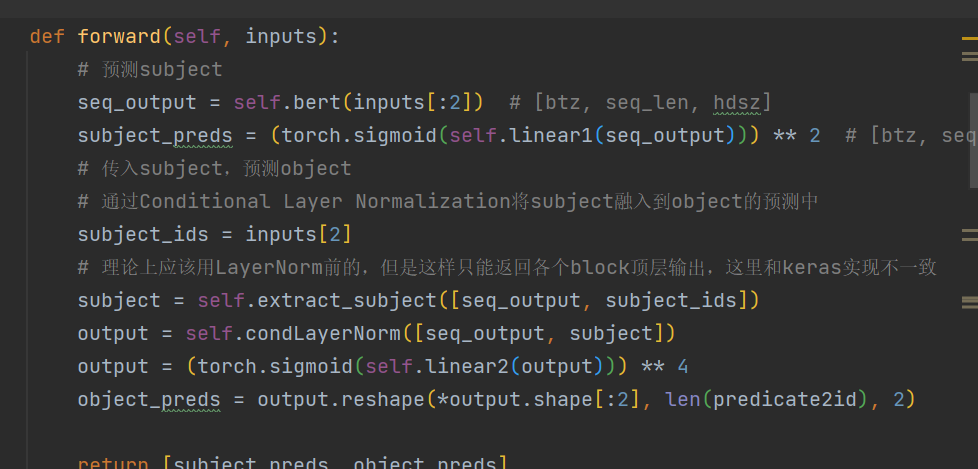比如这个代码case:
你能提供预测新的文本的inference代码吗?
#! -- coding:utf-8 --
情感分类任务, 加载bert权重
valid_acc: 94.72, test_acc: 94.11
from bert4torch.tokenizers import Tokenizer
from bert4torch.models import build_transformer_model, BaseModel
from bert4torch.snippets import sequence_padding, Callback, text_segmentate, ListDataset
import torch.nn as nn
import torch
import torch.optim as optim
import random, os, numpy as np
from torch.utils.data import DataLoader
from tensorboardX import SummaryWriter
maxlen = 256
batch_size = 16
config_path = 'F:/Projects/pretrain_ckpt/bert/[google_tf_base]--chinese_L-12_H-768_A-12/bert_config.json'
checkpoint_path = 'F:/Projects/pretrain_ckpt/bert/[google_tf_base]--chinese_L-12_H-768_A-12/pytorch_model.bin'
dict_path = 'F:/Projects/pretrain_ckpt/bert/[google_tf_base]--chinese_L-12_H-768_A-12/vocab.txt'
device = 'cuda' if torch.cuda.is_available() else 'cpu'
writer = SummaryWriter(log_dir='./summary') # prepare summary writer
固定seed
seed = 42
random.seed(seed)
os.environ['PYTHONHASHSEED'] = str(seed)
np.random.seed(seed)
torch.manual_seed(seed)
torch.cuda.manual_seed(seed)
建立分词器
tokenizer = Tokenizer(dict_path, do_lower_case=True)
加载数据集
class MyDataset(ListDataset):
@staticmethod
def load_data(filenames):
"""加载数据,并尽量划分为不超过maxlen的句子
"""
D = []
seps, strips = u'\n。!?!?;;,, ', u';;,, '
for filename in filenames:
with open(filename, encoding='utf-8') as f:
for l in f:
text, label = l.strip().split('\t')
for t in text_segmentate(text, maxlen - 2, seps, strips):
D.append((t, int(label)))
return D
def collate_fn(batch):
batch_token_ids, batch_segment_ids, batch_labels = [], [], []
for text, label in batch:
token_ids, segment_ids = tokenizer.encode(text, maxlen=maxlen)
batch_token_ids.append(token_ids)
batch_segment_ids.append(segment_ids)
batch_labels.append([label])
batch_token_ids = torch.tensor(sequence_padding(batch_token_ids), dtype=torch.long, device=device)
batch_segment_ids = torch.tensor(sequence_padding(batch_segment_ids), dtype=torch.long, device=device)
batch_labels = torch.tensor(batch_labels, dtype=torch.long, device=device)
return [batch_token_ids, batch_segment_ids], batch_labels.flatten()
加载数据集
train_dataloader = DataLoader(MyDataset(['E:/Github/bert4torch/examples/datasets/sentiment/sentiment.train.data']), batch_size=batch_size, shuffle=True, collate_fn=collate_fn)
valid_dataloader = DataLoader(MyDataset(['E:/Github/bert4torch/examples/datasets/sentiment/sentiment.valid.data']), batch_size=batch_size, collate_fn=collate_fn)
test_dataloader = DataLoader(MyDataset(['E:/Github/bert4torch/examples/datasets/sentiment/sentiment.test.data']), batch_size=batch_size, collate_fn=collate_fn)
定义bert上的模型结构
class Model(BaseModel):
def init(self) -> None:
super().init()
self.bert, self.config = build_transformer_model(config_path=config_path, checkpoint_path=checkpoint_path, with_pool=True, return_model_config=True)
self.dropout = nn.Dropout(0.1)
self.dense = nn.Linear(self.config['hidden_size'], 2)
def forward(self, token_ids, segment_ids):
_, pooled_output = self.bert([token_ids, segment_ids])
output = self.dropout(pooled_output)
output = self.dense(output)
return output
model = Model().to(device)
定义使用的loss和optimizer,这里支持自定义
model.compile(
loss=nn.CrossEntropyLoss(),
optimizer=optim.Adam(model.parameters(), lr=2e-5), # 用足够小的学习率
metrics=['accuracy']
)
定义评价函数
def evaluate(data):
total, right = 0., 0.
for x_true, y_true in data:
y_pred = model.predict(x_true).argmax(axis=1)
total += len(y_true)
right += (y_true == y_pred).sum().item()
return right / total
class Evaluator(Callback):
"""评估与保存
"""
def init(self):
self.best_val_acc = 0.
# def on_batch_end(self, global_step, batch, logs=None):
# if global_step % 10 == 0:
# writer.add_scalar(f"train/loss", logs['loss'], global_step)
# val_acc = evaluate(valid_dataloader)
# writer.add_scalar(f"valid/acc", val_acc, global_step)
def on_epoch_end(self, global_step, epoch, logs=None):
val_acc = evaluate(valid_dataloader)
test_acc = evaluate(test_dataloader)
if val_acc > self.best_val_acc:
self.best_val_acc = val_acc
# model.save_weights('best_model.pt')
print(f'val_acc: {val_acc:.5f}, test_acc: {test_acc:.5f}, best_val_acc: {self.best_val_acc:.5f}\n')
if name == 'main':
evaluator = Evaluator()
model.fit(train_dataloader, epochs=10, steps_per_epoch=None, callbacks=[evaluator])
else:
model.load_weights('best_model.pt')















